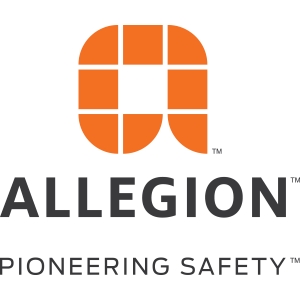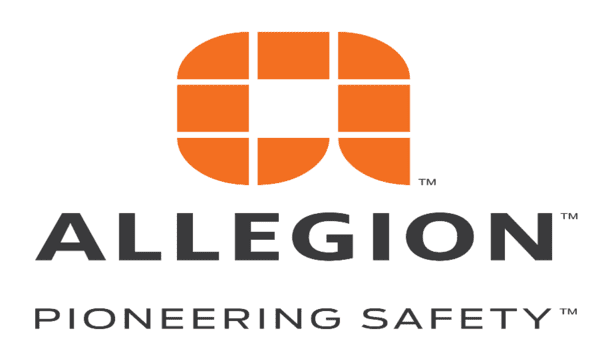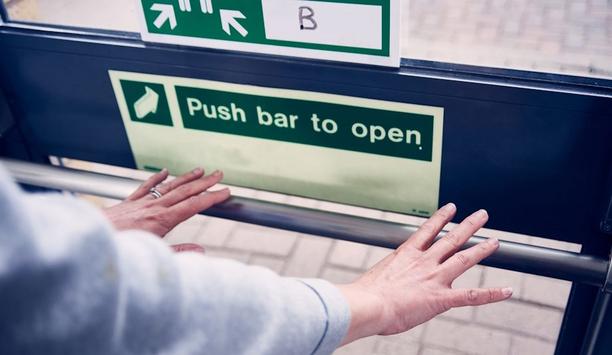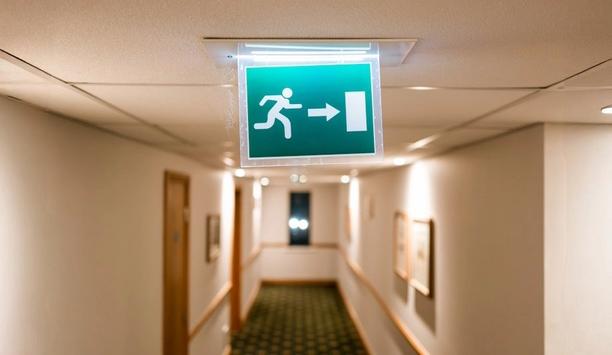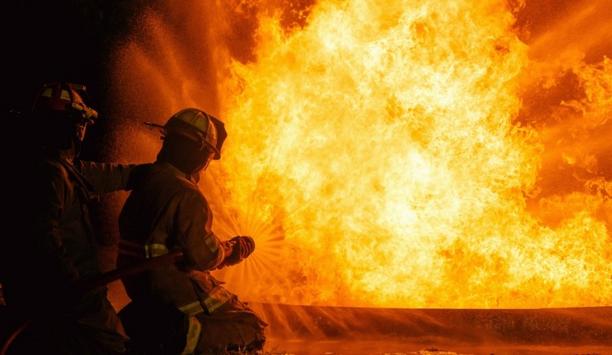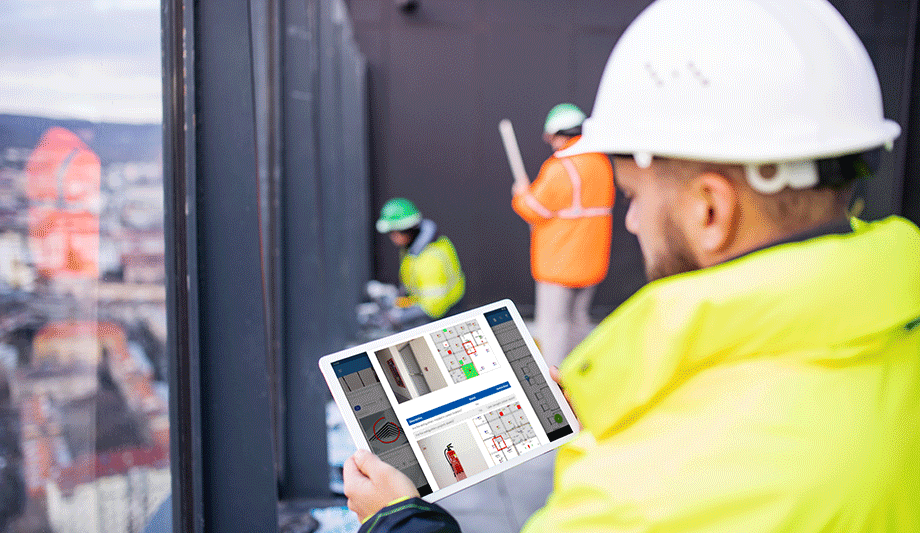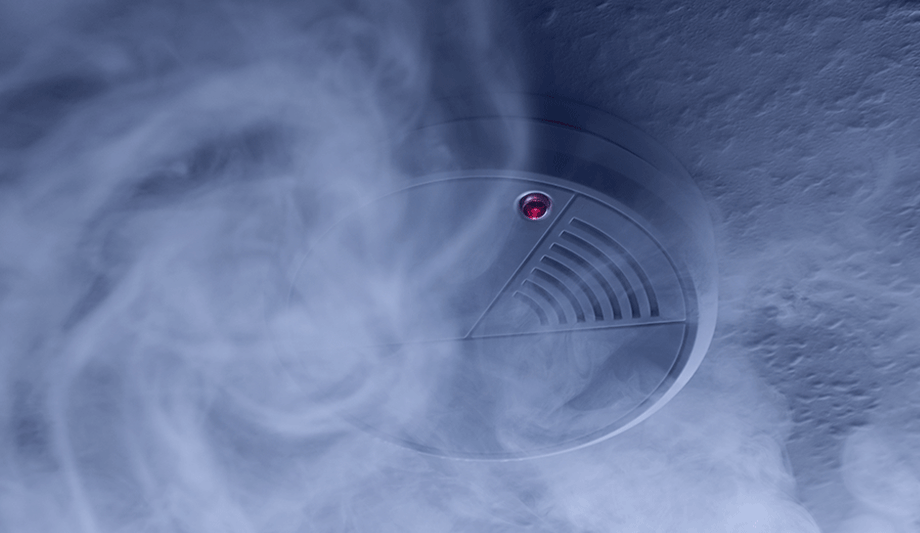Allegion - Experts & Thought Leaders
Latest Allegion news & announcements
Allegion UK, alongside its family of pioneering door hardware brands, is set to present a complete fire door solution at The Fire Safety Event, taking place between the 8th and 10th April at the NEC, Birmingham. With a focus on keeping people safe where they live, learn, work and connect, Allegion’s team of experts will be on hand with specification, installation and maintenance advice at this year’s event, and will showcase a flagship range of fire door solutions, including architectural hardware, fire and smoke seals, vision panels and an intumescent fire block louver system. Set of tested and certified products Allegion is inviting visitors to stand 4/K106 where they can experience three full-sized door models To demonstrate the crucial role that fire door hardware plays in fire safety, Allegion is inviting visitors to stand 4/K106 where they can experience three full-sized door models, each displaying a harmonized set of tested and certified products suitable for timber and steel fire doors. Throughout the three-day event, Allegion will also exhibit a working model of its unique XB120 automatic door operator from Boss Door Controls. Available in a choice of seven high-quality finishes, ranging from ‘Light Bronze’ to ‘Matt Black’, all finish options are designed to enhance all architectural styles. Key element of passive fire protection Speaking on their plans for the event, Pete Hancox, country manager at Allegion UK, commented: “Fire doors are a key element of passive fire protection, and in the event of a fire, it’s crucial that essential door hardware has been expertly specified, correctly installed and properly maintained." "As part of our ongoing campaign to raise awareness and reduce knowledge gaps in these areas, we’re delighted to return to The Fire Safety Event, as it provides the perfect platform to offer valuable expertise and support to a key audience." Highest standards in fire safety management Hancox added: “We will be showcasing the Allegion family of brands at this year’s event and plan to offer visitors true peace of mind by presenting a complete fire door solution that combines a range of our certified, highly-engineered and third-party tested fire door safety products. Our team of experts will also share real-time installation advice, with live demonstrations of our unique self-adhesive Accufit system, which has been enhanced to facilitate easy and accurate installation of our Briton door closers.” The Fire Safety Event supports industry practitioners, professionals and organizations in achieving and maintaining the highest standards in fire safety management, and provides visitors with the perfect opportunity to observe the latest products, technology and solutions in fire safety.
Allegion UK, a pioneer in fire safety hardware and manufacturer of ‘Briton’ door controls, has expanded its library of customer support materials with new installation videos for its highly popular 2003 and 2003V surface-mounted door closers. Aim to publish a video Allegion’s newly published video series provides customers with an illustrative set of installation and adjustment instructions for door mount pull, transom mount, and parallel arm mount fixings across its major product lines. With each video, Allegion aims to improve the accuracy of door closer fittings by delivering a comprehensive walkthrough of the 2003 and 2003V installation process, from the product unboxing to its fixing methods and measurements, as illustrated by Briton’s unique self-adhesive Accufit template system. Step-by-step installation guidance Allegion will shortly complete a suite of digitally curated support materials, which includes technical datasheets With plans to further develop the video library to include step-by-step installation guidance for the Briton 2130B overhead closer, Allegion will shortly complete a suite of digitally curated support materials, which includes technical datasheets, product certifications, fixing templates, and downloadable service and maintenance instructions. Speaking on the ambitions behind the new installation videos, John Fairhurst, business development manager at Allegion UK, commented, “Where the safety of buildings and their occupants is reliant on fire door hardware, we too often identify inaccurate installation as a leading cause for inadequate product performance." Fire door safety standards "To prioritize fire safety, we believe it’s crucial to eliminate the issues associated with incorrect hardware installation, and by adding short and engaging video content to our resources, we can further support our customers in this area." “Driven by our ongoing commitment to improving fire door safety standards, and following the success of our updated Accufit system for the 2003 and 2003V, we have also developed a new Accufit template for the Briton 2130B, which is available now and will feature in a standalone series of installation videos set to launch later this year.”
Allegion UK, a pioneering name in fire safety hardware and manufacturer of ‘Briton’ door controls, has launched a new ‘Fire Door Hardware Fundamentals’ guide, designed to support responsible persons through the latest fire safety regulations and fire door hardware best practice. The newly published guide draws upon key insights from Briton’s pioneering industry experts, and in response to the UK’s developing regulatory framework, aims to deliver accessible information on the Fire Safety Reform Programme and the responsibilities associated with fire door safety. Fire Door Hardware Fundamentals Allegion’s guidance details the pivotal issues associated with fire door safety in the current landscape Allegion’s guidance details the pivotal issues associated with fire door safety in the current landscape and looks to further raise awareness on the role of fire door hardware, before sharing trusted advice on specification, installation, and maintenance. Now available digitally, electronically and in print, the Briton ‘Fire Door Hardware Fundamentals’ guide intends to assist responsible persons, duty holders and trade professionals by providing the foundations and frameworks needed for planning, delivering and maintaining fire door safety strategies in UK buildings. Latest Briton fundamentals guide Speaking on the launch, Pete Hancox, country manager at Allegion UK, commented: “Fire door safety impacts all of our lives and following the latest period of legislative updates, there has been continued discourse concerning accountability, competence and collaboration." "At Allegion, we help keep people safe and secure where they live, learn, work and connect and we believe it’s more important than ever before to understand essential procedures, standards and set guidelines, and in launching our latest Briton fundamentals guide, we’re aiming to bridge the gap between awareness and expertise by providing an invaluable resource to our customers." Fire door hardware specification Hancox added: “Our experience shows us that fire door safety is often compromised due to incorrect fire door hardware specification, poor installation and lack of maintenance and providing a broader understanding of these areas has been crucial to our campaign." "Briton experts share extensive knowledge and know-how in these areas and by applying it throughout this guide, we’re able to deliver a timely and unique piece of literature packed with insightful advice, useful checklists and helpful terminology support.”
Insights & Opinions from thought leaders at Allegion
Healthcare environments are synonymous with caution, wellness and safety. Though, where National Health Service professionals work determinedly to meet the needs of their patients, equally as vital are the fire door safety procedures practiced throughout NHS premises. Fire safety management plays a crucial role in all healthcare settings, where protecting staff, visitors and potentially vulnerable patients is a continuous effort. Highest level of fire safety A survey led by BWF found that 52% of respondents felt hospitals provided fire safety Even with a host of unique operational challenges, hospitals, for example, are often considered to be one of the safest public buildings. In fact, a survey conducted by The British Woodworking Federation discovered that 52% of respondents believed hospitals to provide the highest level of fire safety in a building. Set of fire safety issues Despite these perceptions, NHS data has previously reported a concerning rise in fire incidents across sites around the country. The inherently busy nature of healthcare settings and around-the-clock use of facilities containing vulnerable patients, medical equipment and even flammable materials, presents a complex set of fire safety issues that must be addressed. With that in mind, is there perhaps more work to be done to ensure fire door safety is approached professionally to further mitigate risk? Fire door safety is professionally implemented to further mitigate risk. Health and fire door safety Fire doors play a vital role in protecting each of those individuals, but when paired with the fast-flowing traffic In the three months ending January 2025, an average of 46,000 people visited major hospital A&E departments each day in England, with a further 27,300 visitors attending minor A&E facilities every day. Fire doors play a vital role in protecting each of those individuals, but when paired with the fast-flowing traffic often found in healthcare facilities, this sustained level of footfall can create relentless environments that are unforgiving on fire doors and their hardware. Passive fire protection As a critical element of passive fire protection, fire doors are designed to compartmentalize fire and smoke for a specified period of time. Where fire could spread quickly across the interconnected sections of healthcare estates, fire doors will form protective barriers for a minimum of 30 minutes (FD30) or 60 minutes (FD60), allowing occupants to escape and preventing potentially life-threatening smoke inhalation in the process. Doors are designed to compartmentalise fire and smoke for a specified period of time. Fire doors in healthcare settings Fire doors can only operate effectively when working in tandem with their hardware components Fire doors can only operate effectively when working in tandem with their hardware components, such as hinges, seals, and fire door closers. Yet, all too often in healthcare settings, fire doors and their hardware become damaged and fall victim to improper maintenance and use, with some self-closing doors even propped open to improve the flow of traffic and ease of access for beds, wheelchairs, and medical trolleys. In turn, this leaves closers disengaged and renders doorsets useless in the event of a fire. Effective fire safety procedures Under the Regulatory Reform (Fire Safety) Order 2005, healthcare management teams are given a direct responsibility to ensure employees and patients are safe within their premises. With this, NHS trusts must nominate a ‘responsible person’, which is often an individual who possesses a legal responsibility to demonstrate effective fire safety procedures, undertake risk assessments and meet fire safety compliance. In demanding healthcare environments, regular fire door inspections are key, and as part of their duties, a designated responsible person must have a firm understanding of fire door checks and maintenance, whilst also raising staff awareness on the importance of fire door safety. For this, ongoing education is key. In healthcare environments, regular fire door inspections are key. Prevent and protect In order to retain the integrity of a fire door and its components, healthcare estates must consider how accurate specification, professional installation and ongoing maintenance can help to reduce common hazards and the possibility of danger before it surfaces. Routine fire door checks can save lives and should form the agenda of anyone responsible for fire safety management. They consist of reviewing the specification, installation, condition, and certification of: The door furniture The hinges Locks and latches Door closers Hold open devices Signage Exit devices Door seals The gaps around the door (3mm is recommended for fire doors) UKCA and CE certifications Fire doorsets must pass a series of standardized tests in the form of UKCA and CE certifications When performing a closing action, a fire door calls upon each of these components and as such, not one element can fail in the event of a fire. To meet the necessary standards, the complete fire doorset must pass a series of standardized tests in the form of UKCA and CE certifications, which healthcare officials can identify - alongside a fire door’s FD ratings - by reviewing the label, usually found on the top edge of the door. Fire door regulations Correct specification is essential to long-term performance too. For high-use areas in large hospitals, for example, electromagnetic hold-open devices are a more appropriate choice and allow fire doors to close once a fire alarm is activated, automatically releasing the door in a safe and controlled manner. In smaller, slower-paced settings, cam-action closers with slide arms can fulfill fire door regulations whilst providing ease of operation and accessibility for vulnerable users who may otherwise struggle with heavy doors. Cam-action closers with slide arms can fulfil fire door regulations. Regular maintenance plan for fire doors All healthcare facilities must look to implement a regular care plan for fire doors Regardless of size, layout and the building’s needs, all healthcare facilities must look to inherit a regular maintenance plan for their fire doors and emergency exit routes. In doing so, teams can highlight any early signs that a fire door is not performing as it’s required to, which can help prevent irreparable damage to the door and its hardware - saving the need for replacements and reducing costs for establishments managing budget restraints. When a fire door and its hardware are no longer compliant, teams must ensure repairs and replacements are made quickly and at a professional standard. Fire door safety measures Fire door safety is an ongoing responsibility for healthcare management teams and requires comprehensive planning and regular action. Where patient safety remains the primary focus, a proactive approach is necessary. As such, healthcare officials are urged to pay close attention to their estate’s fire door safety measures, because although fire is unpredictable, it is in most cases preventable.
Safe and seamless movement in our built environment hinges on accurately specified and installed door hardware, explains Russell Marks, managing director of Boss Door Controls. With millions of doors used each and every day, it’s important to recognize the details behind effective access and egress. Whether it’s the regular composite doors found in our homes, the electromechanical access points located in public settings, or the emergency exit fire doors that keep us safe in our work and leisure spaces; door hardware plays an integral role in the safety, security and accessibility of our buildings. Door control components Doorsets are assembled in a variety of configurations, sizes and styles, yet, their operation is always reliant on door control components such as hinges, locks, latches, and door closers. Take fire doors, for example, which are designed to stop the spread of smoke and fire when closed and provide an effective means of escape when open. When operating as intended, a fire door will work in tandem with each of its hardware components, but should one area fail, its fire-resistant capabilities become compromised, leaving a building and its occupants at risk. With that in mind, just how significant is accurate specification and installation? Doorsets are assembled in a variety of configurations, sizes, and styles. Suitable specification Incorrect hardware specification is a common problem associated with building safety. Door controls will directly influence the functionality, accessibility and durability of doors, and as such, it’s essential to understand a building and its user’s needs when choosing between hardware options. Considering factors such as fire safety and inclusive design, specifiers and decision makers are urged to review the door application itself, confirming the chosen hardware meets the required performance ratings, fire ratings, and the latest building standards. Where many buildings require escape routes for example, it is necessary for all doors located on those routes to have suitable exit hardware installed - which is determined by a number of factors including the building’s size and whether it is public facing or not. Incorrect hardware specification is a common problem associated with building safety. Revisions of EN 1125 or EN 179 With occupant safety and legal keeping on the line, it’s clear that specification never undervalued Equally, it is also a legal requirement for all exit devices to comply with the latest revisions of EN 1125 or EN 179 and to possess UKCA and CE markings. With occupant safety and legal compliance on the line, it’s clear that specification should never be undervalued. In fact, by focusing on a project’s requirements as opposed to quick, cost-saving wins, decision-makers can preserve the functionality and safety of buildings whilst adding real value for occupants. Fixing improper installation In many cases, an appropriately specified and perfectly operational door control device can be found ineffective solely as a result of poor installation. Door hardware installation remains a pain point for the fire safety industry specifically, with evidence suggesting that incorrect installation is one of the pioneering causes of fire door failure. Hardware products are often unique to the manufacturer, with distinctive components, fittings and fixing points, and as a result, they should never be approached as like for like installation projects. Instead, during installation, installers must look to follow manufacturer guidelines and fitting instructions. Door hardware installation remains a pain point for the fire industry. Fire door’s integrity With door closers, for example, a fire door’s integrity can quickly become compromised as a result of alignment issues and improper installation methods. Consequently, a fire door may not be able to latch or close fully from its standing position, leaving gaps large enough for smoke and fire to pass through in an emergency situation. Where there is currently no legal framework to assess the competency of installers, it’s important for teams to plan ahead, appreciating that door hardware installation is a specialized task. Fire door’s integrity becomes compromised as a result of alignment issues. Safety standards To further raise safety standards and improve installation accuracy, conscious manufacturers share a wealth of information and detailed walkthroughs in the form of installation templates, product datasheets, and video guides. Additional guidance can usually be found online, with the product packaging, or can be requested directly from the manufacturer. These materials can also be useful post-installation, where teams are required to perform regular maintenance periods as part of their obligations. Conscious manufacturers share a wealth of information. How Allegion UK can help Boss Door Controls is part of the Allegion UK group, known for its wealth of resources designed to help responsible persons, duty holders and professionals undertake product specification, installation and maintenance checks on fire doors and hardware. For accessible fire door hardware support, Allegion’s new ‘Fire Door Hardware Fundamentals’ guide is available for download and combines expert guidance with helpful terminology and useful fire door safety checklists.
Are people too passive when it comes to fire door safety? Research conducted by the British Woodworking Federation (BWF) in 2022 would suggest so, with a third of the British public stating they would not report a problem with a fire door, despite three-quarters of respondents believing a propped open fire door would not perform its role in the event of a fire. From schools and shops to shared areas of employment and accommodation, people are habitually - and sometimes unknowingly - kept safe by passive fire protection systems such as fire doors and their hardware. Yet, in the same breath, occupants and visitors of busy public-facing buildings can be placed in danger by neglected or inappropriately used products. Highlighting these dangers, the Fire Door Inspection Scheme found 75% of inspected fire doors in the UK failed to meet required safety standards in 2021, for example. Importance of fire extinguishers Fast forward to the present day and perceptions are being challenged. Following a period of regulatory updates, greater focus is being placed on the responsibilities associated with both active and passive fire protection, and with a 79% rise in prosecutions related to fire safety violations between April 2023 and March 2024, it certainly pays to pay more attention. Where most recognize the importance of fire extinguishers and smoke detectors, what more can be done to ensure fire doors and their hardware are held in the same regard? Occupants and visitors of busy public-facing buildings can be placed in danger. Regulated and relied upon Passive fire protection is identified as the group of structural measures designed to inhibit the spread of smoke and fire. Frequently hidden in plain sight and sometimes taken for granted, fire doors are a key element of any building’s passive fire safety system and should never fall under neglect. In fact, fire doors are often the first line of defence against fire and smoke, and when closed, will compartmentalize spaces to protect property and provide occupants with an opportunity to escape. Fire doors are a key element of any building’s passive fire safety system. Such is their importance to public safety; fire doors are acknowledged by several professional bodies and are listed as a legal requirement in all non-domestic premises and houses in multiple occupations (HMOs). Under the recently updated Regulatory Reform (Fire Safety) Order 2005, a building’s designated Responsible Person (RP) must perform regular duties to review the condition of fire door systems, while providing residents with access to comprehensive fire safety information in the process. Fire door hardware Functional fire doors and clear exit routes are critical in ensuring appropriate precautions and preventative measures are in place and as such, responsible persons must recognize that a building’s fire doors will not perform as intended unless essential hardware has been correctly specified, installed, and maintained. As correctly acknowledged by most of the British public, an open fire door is rendered useless in the event of a fire and to form an effective barrier against fire and smoke, fire doors must be capable of closing fully from an open position. When performing a closing action, a fire door will call upon its hinges, locks, latches and door-closing devices, and in the event of a fire, not one of these elements can fail. In view of this, fire door hardware is methodically designed and tested to support the integrity of fire doors. To meet necessary standards, a fire doorset must pass one or more of a series of standardized tests, confirming its UKCA and CE certifications and FD ratings. Users can identify a certified fire door by its label, usually found on the top edge of the door. Functional fire doors and clear exit routes are critical in ensuring appropriate precautions. Shared responsibilities and results As part of their research in 2022, the BWF found that almost half of those who neglect to report a problem with fire doors would not take action because they were unsure who to report it to, or cited it was simply not their place or role to report it. Seemingly then, in many cases, improved communication and education towards fire door safety can help mitigate risk and further raise standards across the built environment. In any circumstance, people must continue being urged to keep buildings safe by reporting damaged or propped open fire doors to designated responsible persons. In higher-risk buildings where many rely on the same fire safety systems for example, it’s imperative that people know who they can turn to when a fire door safety issue arises, and often, this will be the landlord, owner, manager, or occupier of the premises. Equally, responsible persons must also adopt a hands-on approach by ensuring fire doors and their hardware are ‘subject to a suitable system of maintenance and are maintained in an efficient state, in efficient working order and in good repair’, as per the Regulatory Reform (Fire Safety) Order 2005. Higher-risk buildings where many rely on the same fire safety systems. True purpose of fire doors Where a fire alarm will inform you when something is wrong, fire doors require more proactive methods. As part of their ongoing maintenance duties, responsible persons should perform quarterly checks on fire doors, assessing the certification, gaps, seals, hinges and closing elements. Even durable door hardware can become worn and tired in high-footfall environments and may need repairing or replacing over time. An incorrectly installed or damaged self-closing device, for example, can limit the closing action of a fire door and prevent it from fully closing into the frame. Upon inspection, if a fire door isn’t operating as intended, it’s imperative to seek out professional advice and ensure maintenance or replacement is carried out quickly and professionally. Whilst many of us use them day to day without thought, the true purpose of fire doors must remain clear at all times. Collectively, we must continue to change the perceptions associated with passive fire protection methods and fire door safety, and only when we improve collaboration and communication will we truly limit the devastation of fire. Simply put, there is a chain of responsible parties, and everyone must recognize what their role is - we all must do better. Fire doors require more proactive methods. How Allegion UK can help Allegion UK has a wealth of resources designed to help responsible persons, duty holders and professionals undertake product selection, installation and maintenance checks on fire doors and hardware. For accessible fire door hardware support, Allegion’s new ‘Fire Door Hardware Fundamentals’ guide is available for download and combines expert guidance with helpful terminology and useful fire door safety checklists.
The New Future For Fire Agencies
DownloadThe Eight Key Trends in Fire Detection in 2023
DownloadA Digital Platform to Improve Fire Safety Compliance and Inspections
DownloadOvercoming the Challenges of Fire Safety in the Paper Industry
DownloadCarbon Monoxide: Creeping Killer Caught In The Act
DownloadBriton 2003V Overhead Door Closer
Briton 1120B Overhead Door Closer
Briton 2700 Cam Action Door Closer










